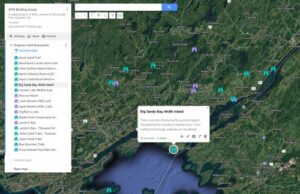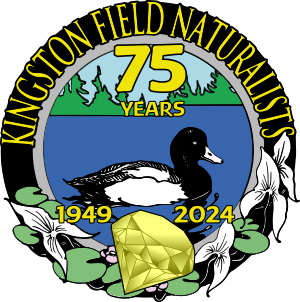Interactive Birding Areas Map

🗺 The Kingston Field Naturalists maintains an interactive Google Map of Birding Areas. Click on the map to get started.
Birding Hot Spots of the Kingston Region
This is a list of the most popular sites in the area to find birds. Most of these sites are visible on Google Maps and all are listed as hotspots on eBird. You can get an idea of what is being seen at the moment by navigating to the hotspot page, clicking on View Details. (example – https://ebird.org/canada/hotspot/L298965 is the page for Lemoine Point CA). Clicking on Illustrated Checklist on the left sidebar will bring up a list of all birds that have been reported at the site with bar charts showing when they are likely to be seen.
Birding Howe Island
Birding Moscow Marsh – a Site Guide
Birding Marshlands CA – a Site Guide
City of Kingston
- Lemoine Point Conservation Area: a busy spot, popular with dog walkers, runners and cyclists, but it also houses a wide variety of birds. Birding can be good in all seasons.
- Marshlands Conservation Area: a narrow and often muddy path leads through areas of scrub, trees and wetlands that attract many migrant birds. See the KFN Marshlands CA site guide for further detail (copyright reserved by Kingston Field Naturalists).
- Belle Park: waterfowl and marsh birds can be seen from the paths.
- Kingston Inner Harbour: a good spot for migrating waterfowl. Look for birds from Lilla Burke Park in the morning (with the sun at your back). In the afternoon check the action at Doug Fluhrer Park, the K&P Trail near the Kingston Canoe Club, and from the path below the Village on the Green apartment buildings.
- Cataraqui Bay/Elevator Bay: an excellent spot for migrating waterfowl, though there are no really good viewing locations. The inner bay can be viewed from the railroad tracks and King Street; spots for looking over the outer bay include Invista (see below), at the side of ever- busy Front Road, and from Lake Ontario Park.
- Invista Lagoon: a waste-water pool that stays open throughout the winter. In winters where there is lots of ice on the river and lake this site can be teeming with ducks and swans.
Near Kingston
- Amherstview Sewage Lagoons: Open to KFN members only. Combination lock on gate. Waterfowl and, when water levels are low, shorebirds
- Wolfe Island: a premier site for winter birding, featuring Snowy Owls, Red-tailed and Rough-legged Hawks, Northern Harrier, and frequently Snow Bunting and Horned Lark. Good for waterfowl in fall, winter and spring; swallows and sparrows in spring, summer and fall.
- Howe Island: this island east of Wolfe Island has some good birding opportunities whether viewing from roadsides, walking the Howe Island Trail or exploring the shoreline by canoe or kayak. See the KFN Birding Howe Island guide for further detail.
- Little Cataraqui Creek Conservation Area: Forest birds, spring and fall migrants.
- Morven/Big Creek – near the village of Morven there are several sites along Big Creek that are popular with shorebirds in the spring. Try the bridge on Big Creek Road just east of Townline Road, the first 2-300m of Big Creek west of Townline Road, and the bridge at the junction of Perry Road and Chambers Road.
- Locks on the Rideau Canal – Kingston Mills, Lower Brewers Mills, Chaffey’s Locks: good spots for Trumpeter and Mute Swans in the winter
- Amherst Island: waterfowl year-round, forest and grassland birds in spring/summer/fall, shorebirds on migration. In the winter can be very good for raptors. See the KFN Amherst Island guide for further detail (copyright reserved by Kingston Field Naturalists).
- Frontenac Provincial Park: Forest birds, breeding warblers in the summer.
- Canoe Lake Road and Opinicon Road: breeding warblers (including Cerulean, Golden-winged and Blue-winged) in summer, flycatchers, vireos and Whip-poor-will in season. See the KFN Opinicon Road guide for further detail (copyright reserved by Kingston Field Naturalists).
- Moscow Marsh: prime site for wetland birds. See the KFN Moscow Marsh Site Guide.
- Camden Lake Provincial Wildlife Area: good site for waterfowl including breeding Common Loon; a trail through the woods can be productive during spring migration.
Farther Afield
- Prince Edward Point: Superior site for migrant passerines. Good for scoters, mergansers and ducks in spring and fall. Sites to visit include Prince Edward Point Bird Observatory, Point Traverse Woods, Little Bluff Conservation Area, plus a number of roadside lookouts
- Presqu’ile Provincial Park. The best site for migrating shorebirds in Eastern Ontario. Lighthouse Woods is a well-known migrant trap. Presqu’ile Bay is good for waterfowl, especially in March/April.

